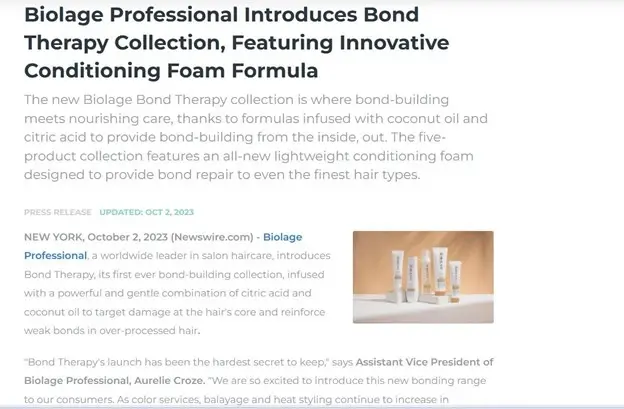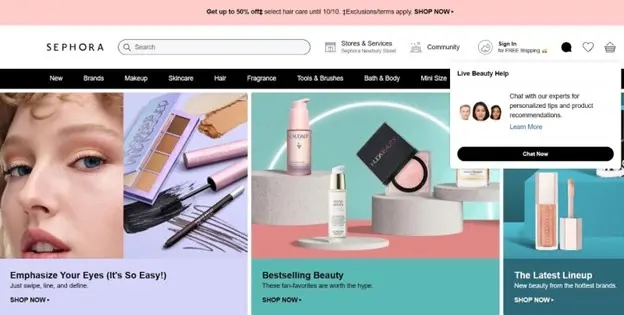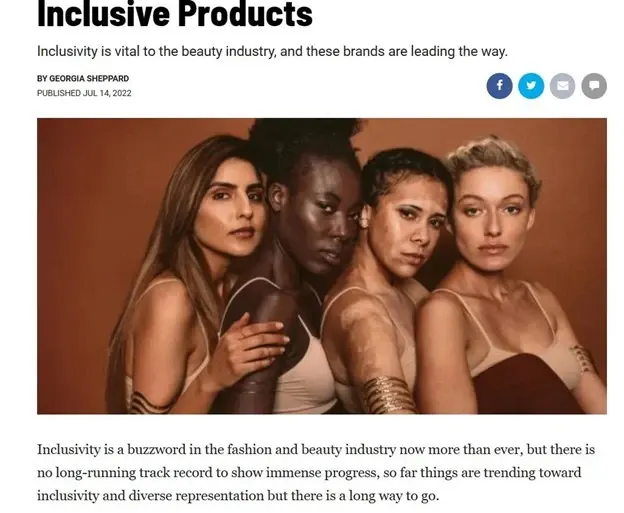10 Top Beauty Marketing Trends and Tips for 2024
- Home
- Intelligent Insights Blog
- 10 Top Beauty Marketing Trends and Tips for 2024
When it comes to the beauty industry, trends are everything. And beauty marketing is no different. A catchy tagline can be as impactful as an innovative contour palette.
But that’s also what makes beauty marketing so challenging. Consumers have high expectations and there’s a lot of competition to stay ahead of trends.
You need to remain relevant while standing out from the crowd. You need to understand the current interests of consumers so you can adapt.
Additionally, the beauty industry continually embraces innovation. Not only do you need to produce cutting-edge products, you also need to find new ways to reach consumers and showcase products.
How do you even begin to keep up?
You’ll want to start by checking out the latest beauty marketing trends. Then you’ll want to incorporate new tech and ideas into your marketing and PR strategies. Do it right, and you’re ahead of the curve.
Want to hear the best news?
You don’t have to search every corner of the Internet to find these trends and ideas. We’ve got 10 of the most relevant beauty marketing trends listed right here.
Want help getting started on revamping your marketing and PR strategies?
Let us help. Book a free consultation with one of our PR and marketing experts. We’ll take a look at your current strategies and see where they could benefit from a refresh.
Our Top 10 Beauty Marketing Trends 2024
- Public Relations for Brand Promotion
- E-commerce as a Marketing Channel
- Natural Beauty Marketing
- Diversified Marketing
- Influencer Collaborations
- Cleaner and Sustainable Beauty Products
- Augmented Reality
- Artificial Intelligence
- Video Content
- High-Resolution Photos
1. PR is an Effective Way to Promote Your Brand
In the world of beauty, PR may stand for “pretty remarkable.” But on a serious note, it’s public relations.
PR has long been a cornerstone of beauty marketing. It remains a powerful tool and one of the most important beauty marketing trends today.
Media coverage, press releases, and partnerships with influencers or beauty experts can generate buzz and create a wider reach than traditional advertising or marketing alone.
When your beauty products or services receive positive coverage in reputable media outlets, it lends authenticity and validation to your brand.
Plus, consumers seek genuine connections with brands.
To make PR one of your beauty marketing trends, craft compelling narratives around your beauty products. Highlight the journey, inspiration, and ingredients behind each product.
The press release below from Biolage Professional how PR works in the beauty industry:

Pro Tip: PR isn’t just about issuing press releases. Connect with your audience on an emotional level by sharing stories that resonate with their aspirations, insecurities, or desires. Emphasize the transformative power of your products and how they can positively impact consumers’ lives.
Want to learn more about how PR can work in beauty marketing? See our comprehensive guide: How to Write an Effective PR Plan [Tips + Examples]
2. E-commerce Is a Leading Channel for Beauty Products
Who wants to leave their couch when they have a beauty buffet right at their fingertips? That’s why blending marketing and e-commerce is one of the top beauty marketing trends.
The beauty industry has seen a significant shift towards e-commerce, especially in the post-pandemic world. In 2023, the beauty and cosmetics industry in the United States generated about $86 billion in revenue from e-commerce.
If you’re looking to join the e-commerce craze, try using personalized recommendations, subscription services, and virtual consultations. They provide customers with tailored product suggestions and expert guidance.
Also, ensure your e-commerce website is user-friendly, mobile-responsive, and loads quickly. Implement easy navigation, search filters, and personalized product recommendations.
To get an idea of how a strong e-commerce site looks, check out this example from Sephora:

Pro Tip: Create informative and engaging content that educates customers about your beauty products. This can include catchy copywriting and captivating images. It can also include more general educational content that talks about unique beauty trends, tips, and insights.
Want to get a deeper insight into content marketing for 2024? Then you’ll want to check out our trends list: 7 Top Content Marketing Trends 2024 [+ Tips and Tricks]
3. Natural Beauty Marketing Takes Center Stage
Step aside Hollywood! The beauty industry is increasingly adopting natural beauty and one of its top beauty marketing trends, challenging the era of over-edited images.
Many beauty marketing efforts have shifted their focus toward a genuine definition of beauty. This includes minimal retouching and showcasing stretch marks, scars, body hair, and natural physiques in their visuals.
Consumers appreciate seeing real people with imperfections and relatable features in marketing campaigns. This authenticity builds trust and resonates with consumers who may have felt alienated by traditional beauty standards.
To promote natural beauty in your marketing efforts, try creating educational content that helps consumers embrace natural beauty products. This could include tutorials on self-care practices.
This Pinterest post is an example of how other brands are leaning into natural beauty as one of their beauty marketing trends:

Pro Tip: Encourage your customers to create and share their own content featuring your products. User-generated content serves as authentic testimonials and showcases real people using your products in their daily beauty routines.
4. Diversified Marketing Becomes More Important Than Ever in the Beauty Industry
In the ever-evolving beauty industry, one-size-fits-all is so last season.
Inclusivity isn’t just one of the most current beauty marketing trends; it’s an essential aspect of modern beauty.
The beauty industry is incredibly diverse, with consumers of all backgrounds and identities. Many beauty brands are recognizing the importance of inclusivity and diversity in their marketing campaigns.
Ensure your marketing materials reflect diverse skin tones, hair types, genders, and ages. This helps you connect with a more diverse audience.
Want to know what makes diversity one of the most current beauty marketing trends? Here is an example of what inclusive beauty marketing looks like:

Pro Tip: Provide clear and comprehensive product information, including shade ranges, undertones, and suitability for various skin types, to help customers make informed choices.
5. Influencers Are Endorsing Beauty Products
Influencer marketing remains a dominant force in the beauty industry. There are currently over 1,000 beauty influencers operating on YouTube and Instagram alone. Plus, many more have dedicated followings on TikTok.
Why else is influencer marketing one of the most successful beauty marketing trends?
Consumers today are becoming more discerning. They value authenticity over mere endorsements. Successful influencer partnerships are a great way to focus on genuine product experiences, honest reviews, and relatable content.
Choose influencers whose values, style, and audience align with your brand. It’s essential that the influencer genuinely resonates with your products.
Encourage influencers to share their honest experiences with your beauty products. Urge them to include both the pros and cons, so consumers get an honest review.
Here’s an example of what influencer marketing looks like in the beauty industry:
Pro Tip: Consider working with micro-influencers. These are influencers with smaller but more niche and dedicated audiences. Their recommendations often carry more weight than other types of influencers or celebrities.
Want to make influencer marketing work for your brand? See our article: 9 Top Influencer Marketing Trends Shaping the Industry in 2024
6. More Consumers Are Looking for Cleaner and Sustainable Beauty Products
Today’s glam is greener than ever. Sustainability is no longer a niche concern—it’s a mainstream consideration for beauty consumers.
Brands are responding by implementing sustainable practices across their supply chains and packaging. But how do you incorporate sustainability into your marketing and PR strategy?
To become a part of this growing initiative, highlight eco-friendly initiatives. This includes recyclable packaging, reduced carbon footprints, and cruelty-free certifications.
Also, back up your sustainability claims by obtaining recognized certifications. This can include USDA Organic, Fair Trade, or cruelty-free certifications.
Want to know how environmental sustainability has become one of the newest beauty marketing trends? See the example below on sustainable cosmetics packaging from Sulapac:

Pro Tip: Share your brand’s Corporate Social Responsibility sustainability initiatives. You can do this on your website, through thought leadership, and via a PR strategy. Your initiative could include supporting environmental causes, ethical sourcing, or carbon-neutral production.
Want to know more about creating a thought leadership strategy? Read more here: Thought Leadership Strategy: 14 Steps to Balancing Authority and Authenticity (+ Examples)
7. Consumers Can Try Before They Buy With Augmented Reality
What makes AR technology one of the most innovative beauty marketing trends?
It allows consumers to virtually try on makeup products, hairstyles, and skincare regimens before buying. They can do this in real-time through their smartphones or devices.
This immersive experience increases confidence in your products and reduces the risk of buyer’s remorse.
To adopt AR as one of your beauty marketing trends, invest in virtual try-on experiences. Ensure that the virtual try-on is user-friendly, accurate, and realistic.
See the video example below to find out how AR works in beauty marketing:
Pro Tip: Develop AR tutorials that educate consumers on how to use your beauty products effectively. These tutorials can guide users through skincare routines, makeup application techniques, or hair styling tips.
8. Artificial Intelligence is Creating Improved Beauty Shopping Experiences
AI allows beauty brands to create highly personalized experiences for customers. This makes it one of the most innovative beauty marketing trends of 2024.
How does it work?
Machine learning algorithms analyze customer data, such as skin type, tone, and previous purchases. You can use that data to recommend products and routines tailored to individual needs. This personal touch enhances customer satisfaction and loyalty.
This type of AI application is called a recommender system. You can develop recommender systems that match products with consumers based on various parameters. While such a solution requires a developer, more e-commerce sites are using AI-powered recommender systems than ever before. It’s especially worth it for beauty brands with lots of products on their websites.
If you operate an online beauty store, you can also try using AI-powered chatbots and virtual beauty advisors. These provide instant support and guidance to customers. They can answer questions, offer skincare and makeup tips, and assist with product selection.
Amazon Beauty’s recommender system is one example of how AI can help give customers unique recommendations:

Pro Tip: You can also use AI to analyze customer behavior and preferences. Tools like Microsoft’s Power BI allow you to enter data sets and gain insights into which products are most popular, which marketing channels are most effective, and when it’s best to launch promotions.
Interested in AI and marketing automation? Then you’ll want to check out our trends article: 10 Emerging Marketing Automation Trends for 2024
9. Many Beauty Shoppers Prefer Video Content Over Other Media Forms
Who wants to read about beauty products when they can see them in action? The need for visual content is placing video among the top beauty marketing trends.
Video allows you to showcase your products in action. This enables customers to see how they work, along with their texture and results.
Beauty products often require demonstration for effective usage. Video tutorials and how-to guides can educate customers and help build trust in your brand.
To leverage video, create a variety of video content to cater to different customer interests and needs. Consider tutorials, product demonstrations, behind-the-scenes glimpses, customer testimonials, and educational content.
Also, consider live streaming and interactive videos. These can include Q&A sessions or makeup challenges that engage your audience in real-time.
Here is an example of how to adopt video as one of your beauty marketing trends:
Pro Tip: Video is another great media for UGC or influencer collaborations. Showcase real-life transformations and experiences to highlight the effectiveness of your beauty products. Share these videos (with the customers’ permission if UGC) across your social media channels.
Want to know what’s in store for video marketing? Check out our article: Top 10 Video Marketing Trends for 2024 [+ Tips]
10. Beauty Brands Are Using High-Resolution Photos to Showcase Their Product Features
Blurry photos are hard to pass. High-resolution photos capture intricate details and provide clarity. This allows consumers to closely examine product textures, colors, and effects.
High-quality images also convey professionalism and attention to detail. They reflect positively on your brand’s commitment to delivering excellence in both product and presentation.
To use high-resolution photos for maximum impact, maintain a consistent style and theme. Make sure your backgrounds, color schemes, and lighting are consistent.
Consider creating a brand style guide that outlines the preferred image aesthetics, color palettes, and compositions. This ensures uniformity across all marketing materials.
Want to know what it looks like when you make high-resolution photos one of your top beauty marketing trends? Here is an example from Goop that shows how photography can showcase the realistic look and feel of product:

Pro Tip: Go beyond simple product shots and incorporate lifestyle or user-centric images. Show how your beauty products fit into customers’ lives and routines. Use photos of real people using your products. This kind of visual storytelling is more engaging for users.
Once you’ve got great photos, it’s time to share. Check out these social media trends for 2024: 9 Top Social Media Marketing Trends Taking the World by Storm
Key Takeaway on the Latest Beauty Marketing Trends
Competition is high in the beauty industry. To succeed, you must tell the story of your product’s unique selling points and engage with your target audience effectively. Plus, you must be willing to adopt new marketing technologies and types of collaborations.
Beauty trends and consumer preferences can change rapidly. They’re often driven by innovation, social media, and influencers. That’s why staying ahead of beauty marketing trends is crucial for maintaining relevance.
Additionally, consumers are demanding transparency in product ingredients and sustainability. You must find innovative ways to fulfill these expectations while maintaining profitability. Do these things and you can be confident that your marketing and PR efforts will pay off.
Still not sure how to incorporate beauty trends into your marketing and PR mix? Let us help! Simply book a free consultation and we’ll see where your strategy could use a makeover.

